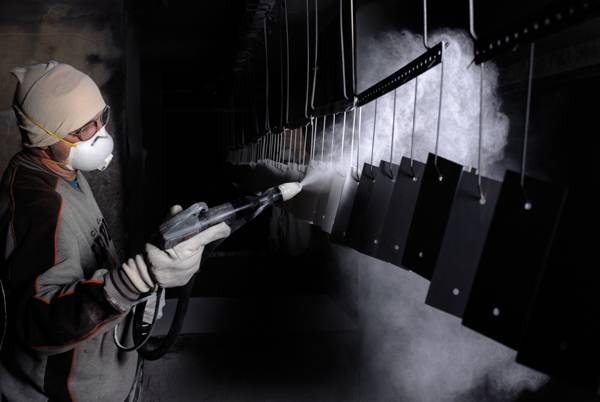
Powder Coating is an alternative to conventional wet painting for automotive and other metal parts. It involves a process by which a layer of specially treated solid pigment in the form of a dry powder is applied to a surface. This surface is then heated, undergoing a chemical reaction as its temperature rises. As a result of this chemical reaction, the powder melts and rehardens into a single solid surface, matching the contours of the item to which it is applied. There are many advantages to Powder Coating over typical wet painting. Aside from being cheaper and more ecologically friendly, Powder Coating also creates a much more durable surface far less likely to scratch and chip.
Before an item can be coated, it must be cleaned and free of any dirt, grease, or oil from the hands. This involves connecting it to an industrial winch and either having the item to be Powder Coated sandblasted or dipped in an acid bath. The surface must then be brushed free of any grit or dried of any remaining moisture. From here the item is connected to a small electrode, imparting a very mild positive electrical charge. The spraying mechanism, similar to a paint gun, is called a Corona Gun. It's a simple air powered device with a hopper containing the powdered pigment in the form of a thermoset polymer. As the powder is fired out the nozzle, the Corona Gun imparts a mild negative electrical charge. This means that the powder and item have opposite charges. These opposite charges will attract one another and the powder will naturally cling to the surface immediately upon contact.
The item covered in powder is then swung over to a large industrial oven. It's fitted inside, making sure to remove the winch chain and electrode, and then baked. The Powder Coating is cooked at 400 degrees Fahrenheit for 10 minutes. During this time, the thermoset polymer which the Powder Coating is made from undergoes a molecular change. It does not just melt and then dry again. It changes at a molecular level, each particle forming molecular bonds with every other surrounding particle to form a single seamless shell surrounding the item. As the polymer is heated, part of it burns, though this is often unseen and creates no noticeable smoke or gas. This burning decreases the number of powder particles, leaving behind a little excess carbon. The remaining particles form bonds with this excess carbon, linking with each other in a lattice-like structure as they do so. The shell is allowed to cool for a few minutes and then removed, complete.